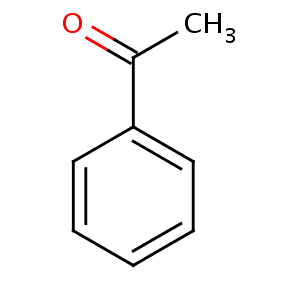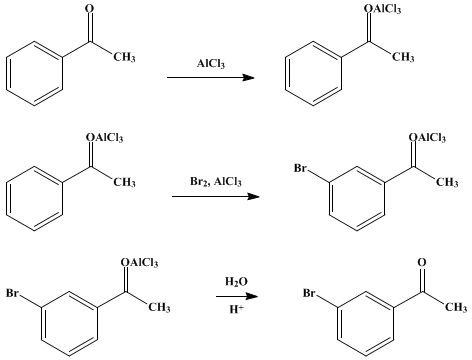Abbreviations ACP Density 1.03 g/cm³ | Formula C8H8O Boiling point 202 °C | |
Manufacturing of industrial chemicals acetophenone alletrhin amyl compounds dye intermediates
Acetophenone is the organic compound with the formula C6H5C(O)CH3 (also represented by the letters PhAc or BzMe), is the simplest aromatic ketone. This colourless, viscous liquid is a precursor to useful resins and fragrances.
Contents
- Manufacturing of industrial chemicals acetophenone alletrhin amyl compounds dye intermediates
- Physical properties of acetophenone carbonyl compounds class 12 chemistry subject lectures cbse
- Production
- Precursor to resins
- Niche uses
- Laboratory reagent
- Drugs
- Natural occurrence
- Pharmacology
- Toxicity
- References

Physical properties of acetophenone carbonyl compounds class 12 chemistry subject lectures cbse
Production

Acetophenone can be obtained by a variety of methods. In industry, acetophenone is recovered as a by-product of the oxidation of ethylbenzene, which mainly gives ethylbenzene hydroperoxide for use in the production of propylene oxide.
Precursor to resins

Commercially significant resins are produced from treatment of acetophenone with formaldehyde and a base. The resulting copolymers are conventionally described with the formula [(C6H5COCH)x(CH2)x]n, resulting from aldol condensation. These substances are components of coatings and inks. Modified acetophenone-formaldehyde resins are produced by the hydrogenation of the aforementioned ketone-containing resins. The resulting polyol can be further crosslinked with diisocyanates. These modified resins are again found in coatings, inks, as well as adhesives.
Niche uses

Acetophenone is an ingredient in fragrances that resemble almond, cherry, honeysuckle, jasmine, and strawberry. It is used in chewing gum. It is also listed as an approved excipient by the U.S. FDA. In a 1994 report released by five top cigarette companies in the U.S., acetophenone was listed as one of the 599 additives to cigarettes.
Laboratory reagent
In instructional laboratories, acetophenone is converted to styrene in a two-step process that illustrates the reduction of carbonyls and the dehydration of alcohols:
4 C6H5C(O)CH3 + NaBH4 + 4 H2O → 4 C6H5CH(OH)CH3 + NaOH + B(OH)3 → C6H5CH=CH2A similar process is used industrially but the hydrogenation step to 1-phenylethanol is done over a copper catalyst.
C6H5CH(OH)CH3 → C6H5CH=CH2 + H2OBeing prochiral, acetophenone is also a popular test substrate for asymmetric hydrogenation experiments.
Drugs
Acetophenone is used for the synthesis of many pharmaceuticals, for example: pyrrobutamine, dextropropoxyphene, trihexyphenidyl, pridinol, aspaminol, Cycrimine, Biperiden, Procyclidine, acifran, Amixetrine, Mesuximide, and Benmoxin. Allegedly also for phenylpropanolamine (note: in this case it is actually propiophenone not PhAc).
Mannich reaction with dimethylamine and formaldehyde was described. This is used to prepare 1-chloro-1-phenyl-3-dimethylaminopropane, which is used to prepare such antidepressants as Ansoxetine, fluoxetine, atomoxetine, and nisoxetine. Using diethylamine instead gives the diethyl analog.
Natural occurrence
Acetophenone occurs naturally in many foods including apple, cheese, apricot, banana, beef, and cauliflower. It is also a component of castoreum, the exudate from the castor sacs of the mature beaver.
Pharmacology
In the late 19th and early 20th centuries, acetophenone was used in medicine. It was marketed as a hypnotic and anticonvulsant under brand name Hypnone. The typical dosage was 0.12 to 0.3 milliliters. It was considered to have superior sedative effects to both paraldehyde and chloral hydrate. In humans, acetophenone is metabolized to benzoic acid, carbonic acid, and acetone. Hippuric acid occurs as an indirect metabolite and its quantity in urine may be used to confirm acetophenone exposure, although other substances, like toluene, also induce hippuric acid in urine.
Toxicity
The LD50 is 815 mg/kg (oral, rats). Acetophenone is currently listed as a Group D carcinogen (Not Classifiable as to Human Carcinogenicity), indicating that it does not produce carcinogenic effects in humans, although no studies on humans have ever been conducted on acetophenones' carcinogenic potential. Studies have shown that acetophenone causes chromosomal damage in hamsters.
